展示 // 世田谷美術館
Exhibition // Setagaya Museum
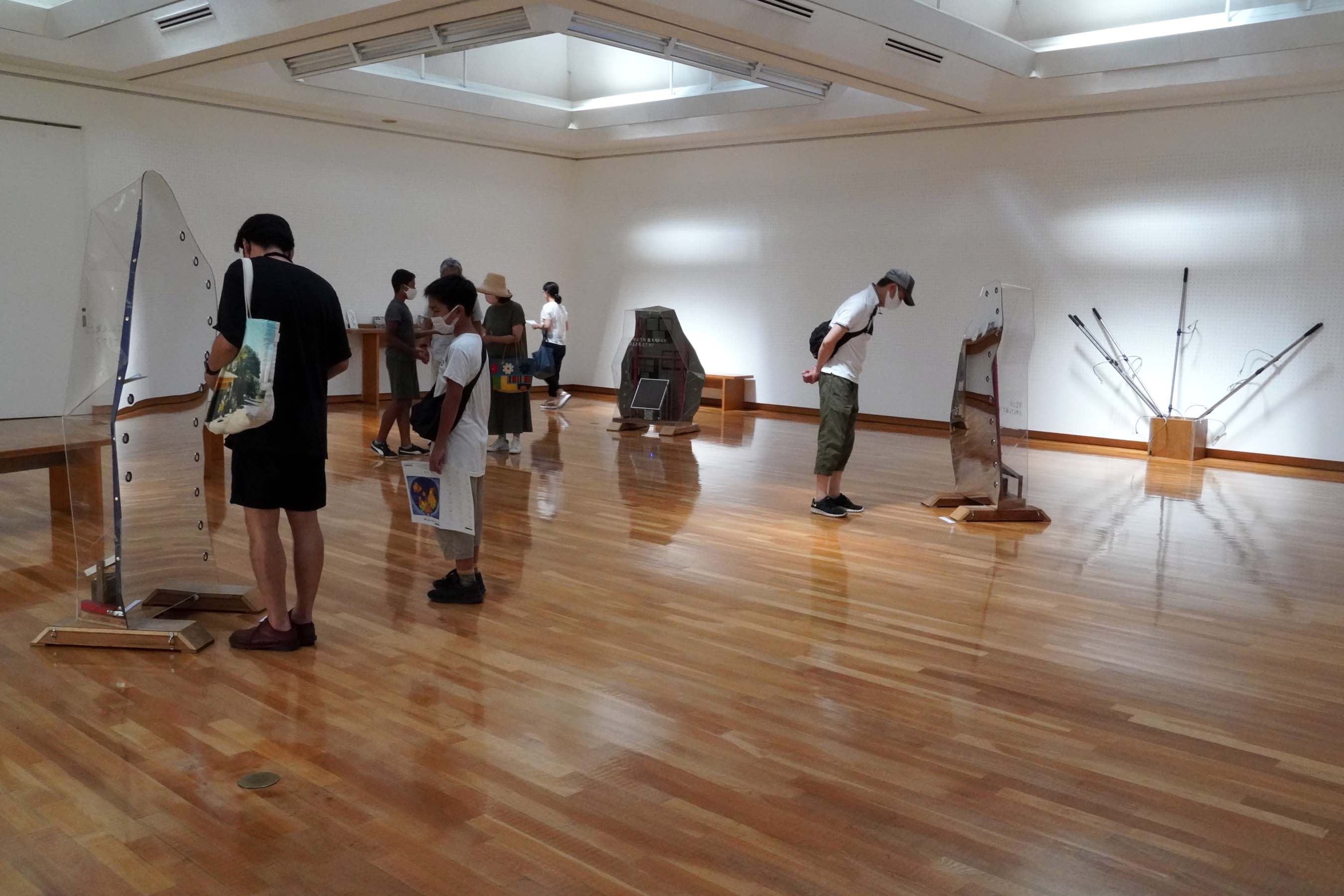
展示情報
7/31(土)と8/7(土)の10:30~12:30にかけては、美術館前広場にてアーティストがモニュメントを運んで歩くパフォーマンスを行います。
Exhibition Information
On July 31 (Sat) and August 7 (Sat), the team will carry the monuments around the museum plaza from 10:30 am to 12:30 pm.


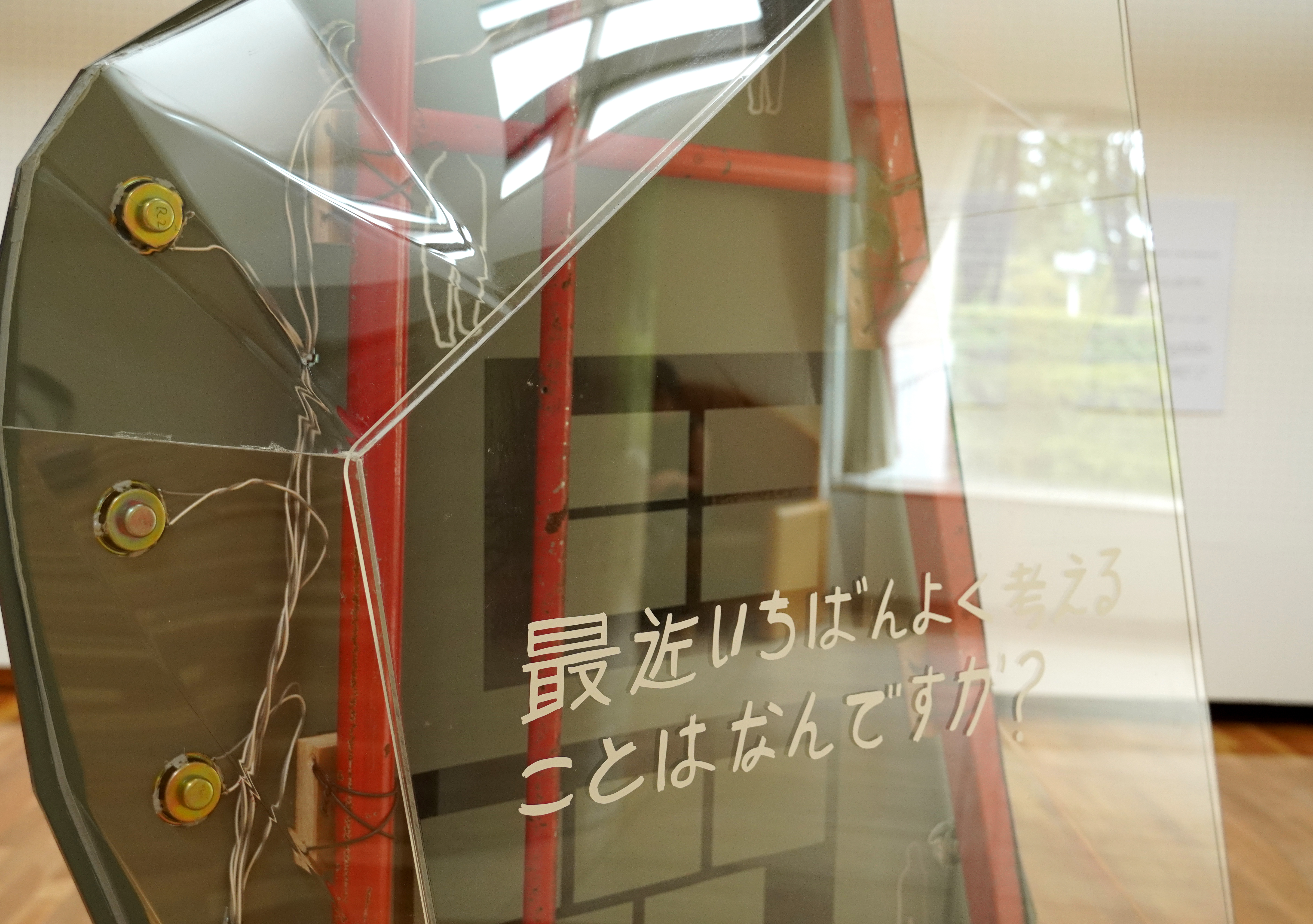

2020年夏の展示を目指して動いてきた「旅はすみか」プロジェクトは、パンデミックの影響を受けて1年延期し、2021年7月の今ここで展覧会にたどり着きました。
コロナ禍の1年半、私たちはたくさんのことを考え直しました。最初の計画では、軽トラックの荷台に書斎を作って東北に向かい、松尾芭蕉が「奥のほそ道」でたどった道を辿り直しながら被災者とともに震災についての俳句を作る予定でしたが、東北に行くことはかなわず、自分の家を出ることすら不可能な日々が続きました。
そんな日々の中で探究を続けるうちに東北に幾つも残る「津波石」の存在を知ります。東北の各地に佇む「津波石」という石碑は過去の災害を記しながらそこで過去の人間の残した声を静かに発しているように感じました。
同時に、人づてによる紹介から紹介という形で東北の方達とオンラインで繋がり始めます。被災の経験を持ち、これから社会に出る若い人たちは対話の中で過去のことよりも今のことを、これからのことを考えたいと語ってくれました。
私たちはそこから、彼ら、彼女たちの今の声を集めて録音し、そして津波石から形を拝借して「声の記念碑」という作品を作ることに決めました。
日本語チームの私たちは、録音されたものを聞いた英語チームの2人の反応からオノマトペの持つ響きの豊かさを知ります。英語と日本語を理解しあおうとする中で言葉になったものやならざるもの、その間にある感触について考えさせられました。
そしてこの夏。いまだ、人が集まるようなイベントをすることが憚られる東京でもまた、人から人への紹介により協力してくださる方を得て作品を制作する場所や公開の機会を得ることができました。
「声の記念碑」は東北の方がそれぞれのご自宅で録音してくれた声を発しながら東京・世田谷の神社やお寺、商店街を練り歩き、プライベートな空間から公共の場へ音を響かせました。それは何か、日常と非日常が逆転しているような今そのものを象徴しているようでもあります。
東日本大震災から10年。コロナウイルスによるパンデミックから1年半。度重なる災害の中、人々の感情は刻々と更新されていきます。だからこそ人との向き合い方を誰もが模索しています。芭蕉が かつて「おくのほそ道」に書いた時から3世紀。
私たちもまた「旅はすみか」の中に生きています。
自分がいる場所を「すみか」とし、今を見つめながら日々を作り続けることで前に進むことができるのかもしれません。
コロナ禍の1年半、私たちはたくさんのことを考え直しました。最初の計画では、軽トラックの荷台に書斎を作って東北に向かい、松尾芭蕉が「奥のほそ道」でたどった道を辿り直しながら被災者とともに震災についての俳句を作る予定でしたが、東北に行くことはかなわず、自分の家を出ることすら不可能な日々が続きました。
そんな日々の中で探究を続けるうちに東北に幾つも残る「津波石」の存在を知ります。東北の各地に佇む「津波石」という石碑は過去の災害を記しながらそこで過去の人間の残した声を静かに発しているように感じました。
同時に、人づてによる紹介から紹介という形で東北の方達とオンラインで繋がり始めます。被災の経験を持ち、これから社会に出る若い人たちは対話の中で過去のことよりも今のことを、これからのことを考えたいと語ってくれました。
私たちはそこから、彼ら、彼女たちの今の声を集めて録音し、そして津波石から形を拝借して「声の記念碑」という作品を作ることに決めました。
日本語チームの私たちは、録音されたものを聞いた英語チームの2人の反応からオノマトペの持つ響きの豊かさを知ります。英語と日本語を理解しあおうとする中で言葉になったものやならざるもの、その間にある感触について考えさせられました。
そしてこの夏。いまだ、人が集まるようなイベントをすることが憚られる東京でもまた、人から人への紹介により協力してくださる方を得て作品を制作する場所や公開の機会を得ることができました。
「声の記念碑」は東北の方がそれぞれのご自宅で録音してくれた声を発しながら東京・世田谷の神社やお寺、商店街を練り歩き、プライベートな空間から公共の場へ音を響かせました。それは何か、日常と非日常が逆転しているような今そのものを象徴しているようでもあります。
東日本大震災から10年。コロナウイルスによるパンデミックから1年半。度重なる災害の中、人々の感情は刻々と更新されていきます。だからこそ人との向き合い方を誰もが模索しています。芭蕉が かつて「おくのほそ道」に書いた時から3世紀。
私たちもまた「旅はすみか」の中に生きています。
自分がいる場所を「すみか」とし、今を見つめながら日々を作り続けることで前に進むことができるのかもしれません。
阿部浩之と遠藤夏香
Originally planned for the summer of 2020, the Tabi Wa Sumika - “Journey Itself Home” exhibition finally opens after a year-long delay from COVID-19.
In pandemic-mode for a year and a half, we were forced to rethink our creative strategies countless times. We had planned to travel to the Tohoku region with a truck outfitted with a gathering space, retracing the steps of Matsuo Basho in his famous work Oku No Hosomichi (The Narrow Road to the Deep North). We wanted to meet with the survivors of the Great East Japan Earthquake and Tsunami to create collaborative haiku. However, the coronavirus made it impossible for us to travel, let alone leave our homes.
During lockdown, we continued our research. We learned about the tsunami ishi, or Tohoku “tsunami stones”. Dotting the Japanese coastline, these stones commemorate past disasters, quietly emanating warnings from ancestors.
Using a friend-to-friend relational network, we connected virtually with dozens of Tohoku young adults who had experienced the disaster. On the cusp of adulthood, the participants shared what was most relevant for them: their feelings of the ‘now’ and their concerns for the future. We decided to collect, record, and amplify their voices through interactive, mobile sound monuments in the shape of existing tsunami stones. For us, they are Koe No Kinen Hi, or ‘voice monuments’.
As Japanese speakers, it was eye-opening for us to see how our American collaborators, Sue and Bruce, responded to the recorded Japanese onomatopoeia as sounds, rather than words with meanings. We came to a whole new understanding of the richness of these onomatopoeia expressions.
In pandemic-mode for a year and a half, we were forced to rethink our creative strategies countless times. We had planned to travel to the Tohoku region with a truck outfitted with a gathering space, retracing the steps of Matsuo Basho in his famous work Oku No Hosomichi (The Narrow Road to the Deep North). We wanted to meet with the survivors of the Great East Japan Earthquake and Tsunami to create collaborative haiku. However, the coronavirus made it impossible for us to travel, let alone leave our homes.
During lockdown, we continued our research. We learned about the tsunami ishi, or Tohoku “tsunami stones”. Dotting the Japanese coastline, these stones commemorate past disasters, quietly emanating warnings from ancestors.
Using a friend-to-friend relational network, we connected virtually with dozens of Tohoku young adults who had experienced the disaster. On the cusp of adulthood, the participants shared what was most relevant for them: their feelings of the ‘now’ and their concerns for the future. We decided to collect, record, and amplify their voices through interactive, mobile sound monuments in the shape of existing tsunami stones. For us, they are Koe No Kinen Hi, or ‘voice monuments’.
As Japanese speakers, it was eye-opening for us to see how our American collaborators, Sue and Bruce, responded to the recorded Japanese onomatopoeia as sounds, rather than words with meanings. We came to a whole new understanding of the richness of these onomatopoeia expressions.
Throughout this project, we’ve tried to understand each other through a mix of English and Japanese, and the meanings that exist between languages. While some of our thoughts and ideas could be verbalized, others remained as feelings. This was the heart of our creative collaborative process.
Now, summer has arrived again. Even though many in Tokyo continue to shy away from holding events and coming together, we found a supportive community in our Setagaya neighborhood. They generously provided us with a work-space as well as many opportunities to engage locally with neighbors.
We went on meditative walks with the Koe No Kinen Hi to local shrines, temples and along shopping streets. The voices of Tohoku survivors, recorded in the comfort of their private homes, resonated in outdoor public spaces. This disjuncture symbolizes our current times, when the ordinary and the extraordinary are inverted.
Ten years have passed since the Great East Japan Earthquake and Tsunami. And we have been living with the COVID-19 pandemic for a year and a half. In the midst of these compounding disasters, a range of new emotions continually arise. Everyone is reflecting on what it means to be with one another.
Three centuries ago, Basho wrote Oku No Hosomichi. Today, we too, experience that the journey---how we choose to live our lives---is our home. By staying attuned to the present and cherishing each moment, we confidently step forward into the unknown.
Now, summer has arrived again. Even though many in Tokyo continue to shy away from holding events and coming together, we found a supportive community in our Setagaya neighborhood. They generously provided us with a work-space as well as many opportunities to engage locally with neighbors.
We went on meditative walks with the Koe No Kinen Hi to local shrines, temples and along shopping streets. The voices of Tohoku survivors, recorded in the comfort of their private homes, resonated in outdoor public spaces. This disjuncture symbolizes our current times, when the ordinary and the extraordinary are inverted.
Ten years have passed since the Great East Japan Earthquake and Tsunami. And we have been living with the COVID-19 pandemic for a year and a half. In the midst of these compounding disasters, a range of new emotions continually arise. Everyone is reflecting on what it means to be with one another.
Three centuries ago, Basho wrote Oku No Hosomichi. Today, we too, experience that the journey---how we choose to live our lives---is our home. By staying attuned to the present and cherishing each moment, we confidently step forward into the unknown.
Hiroyuki Abe & Natsuka Endo




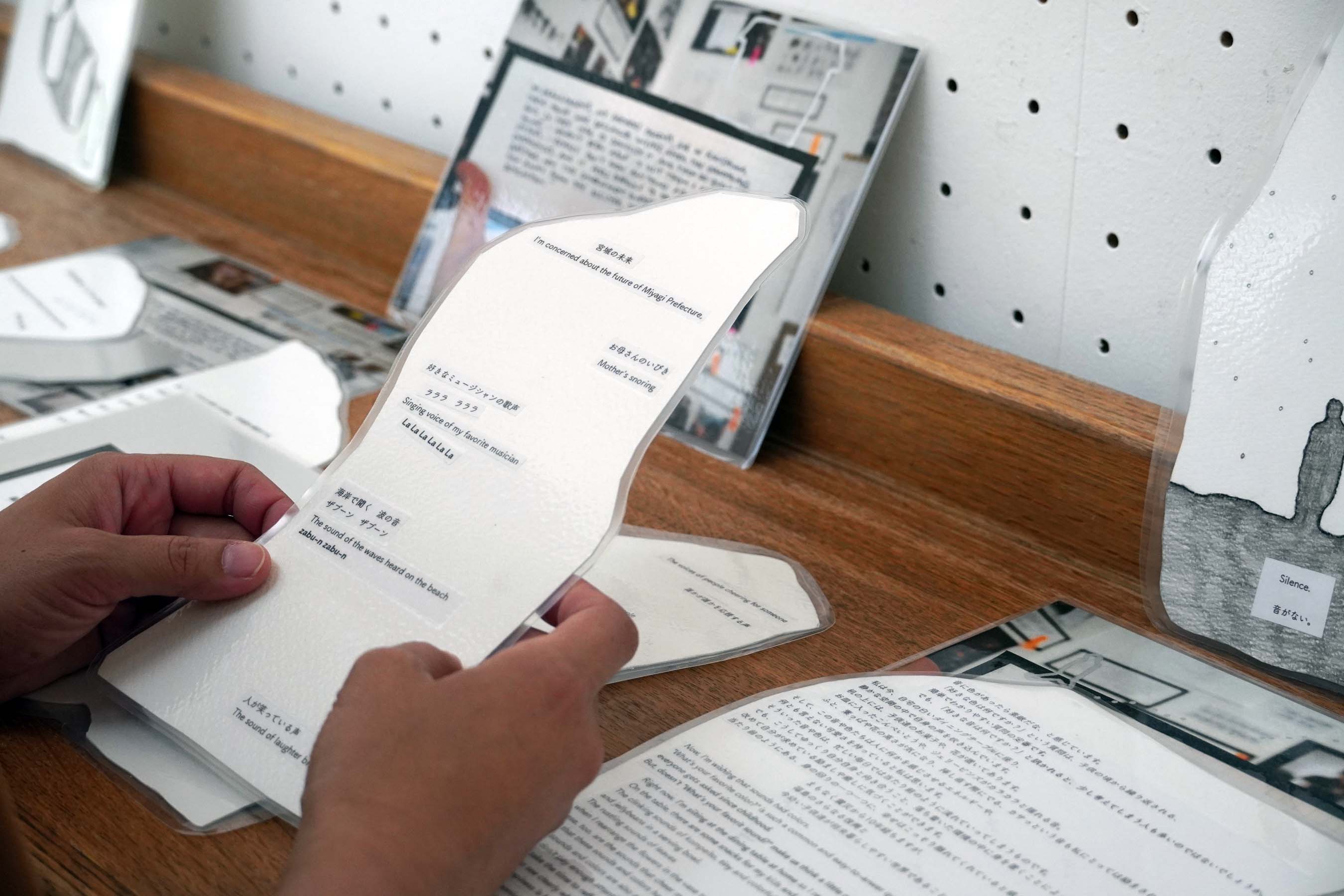
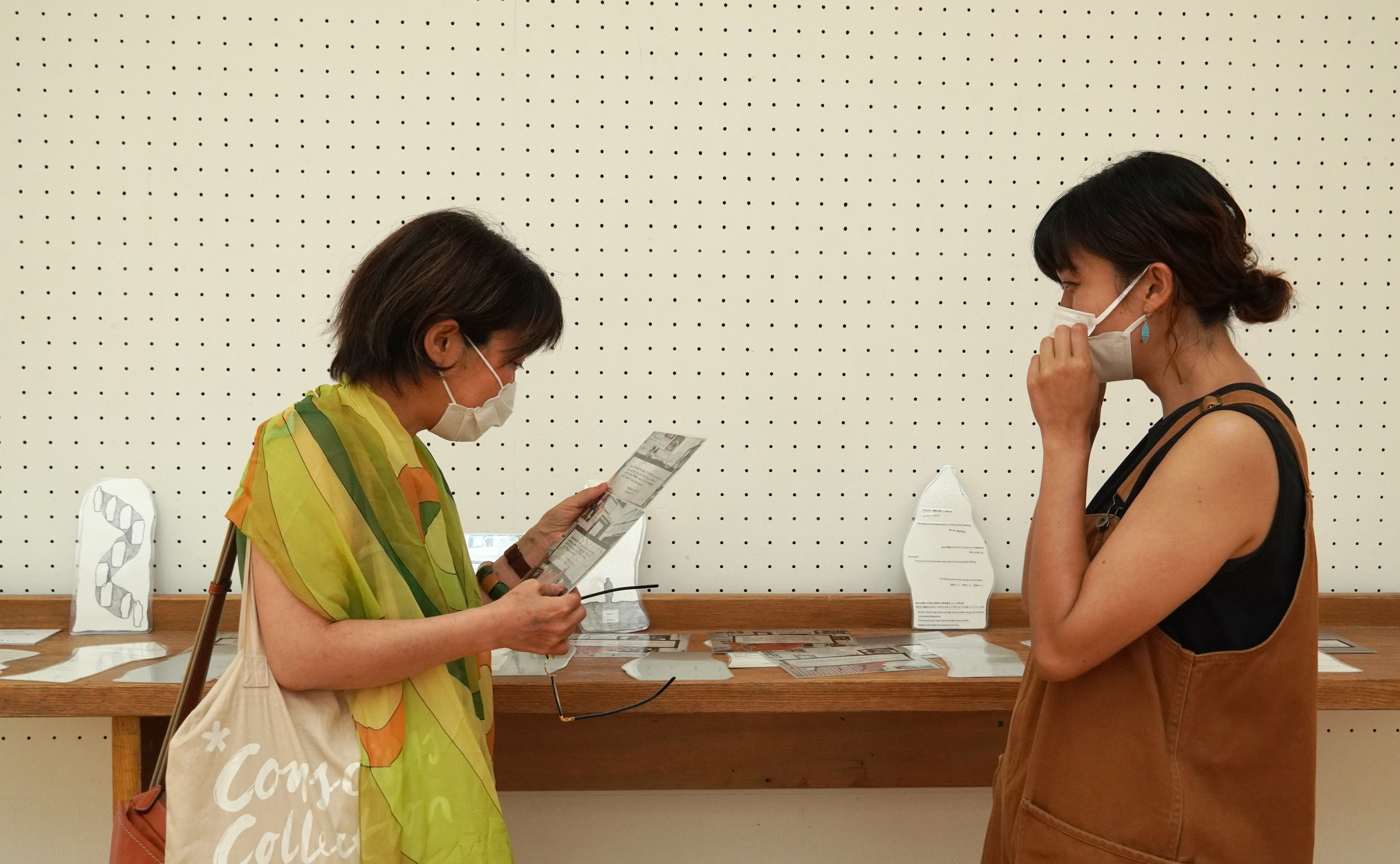

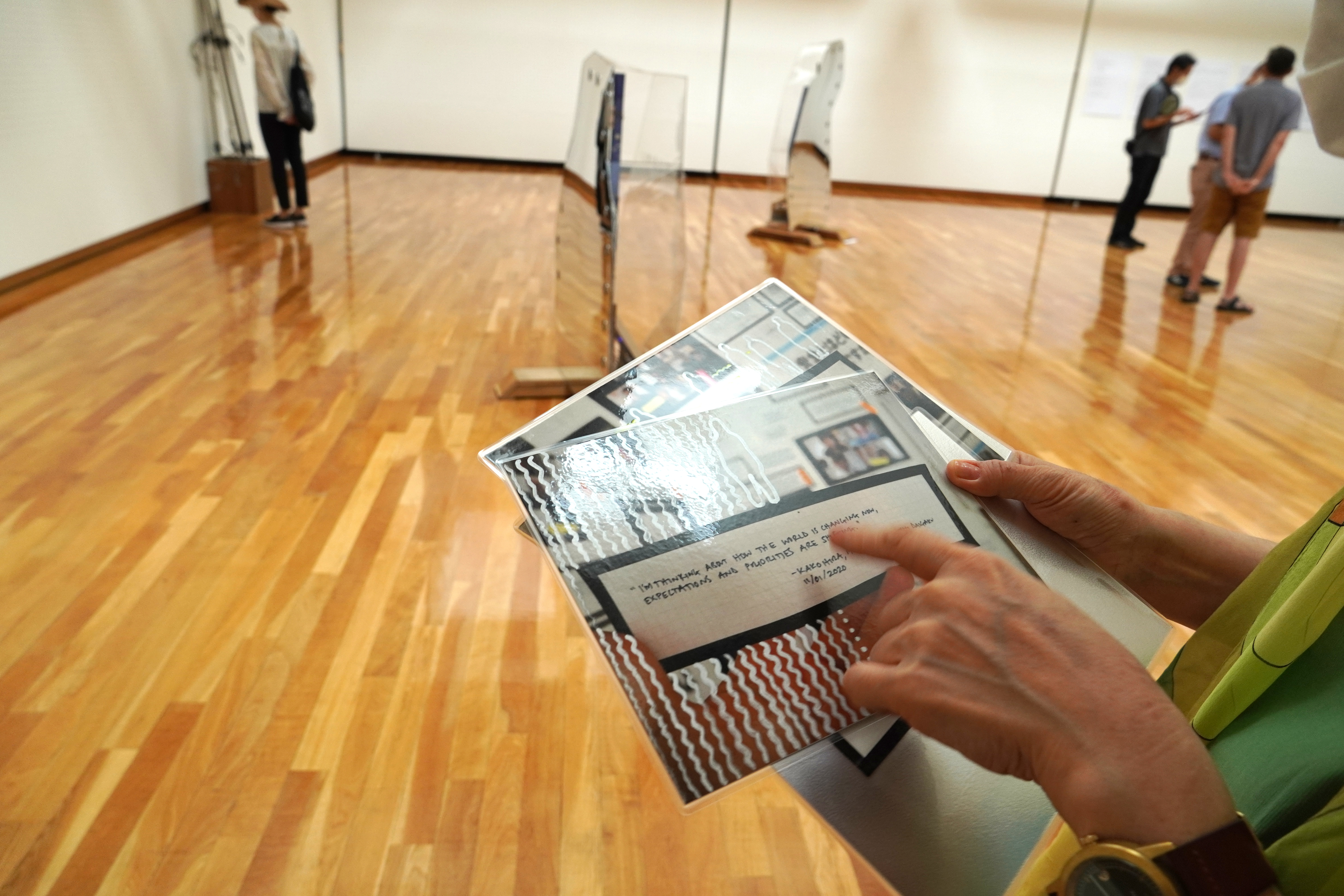
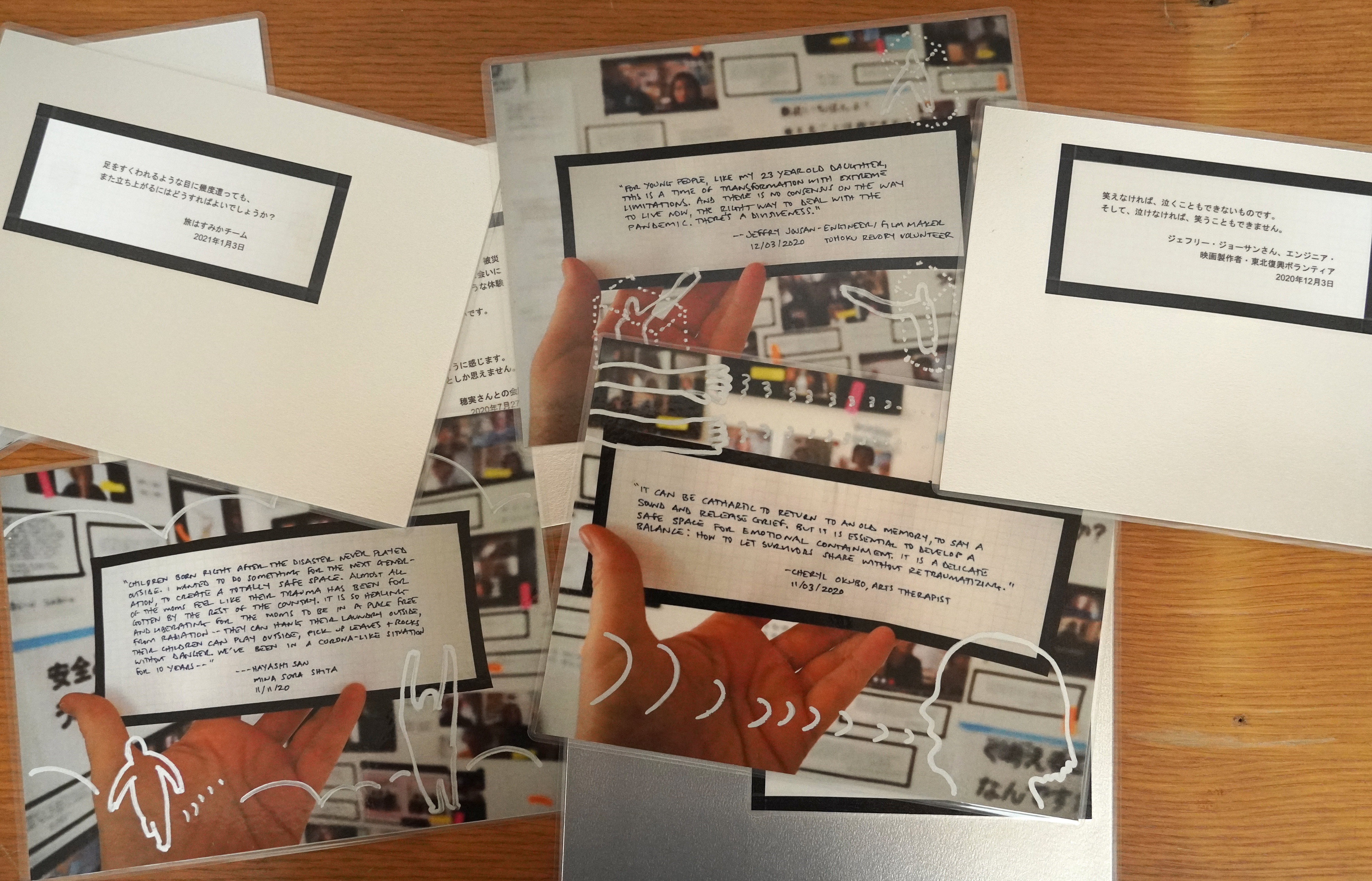

We came together as messengers.
Nichibei synergy, the aggregate of our experiences, knowledge and cultures made an audacious proposition possible: to recognize ten years after the Great East Japan Earthquake and Tsunami.
Cascading challenges prohibited any travel to Tohoku. Pandemic restrictions stretched the boundaries of our imagination.
How to engage with others when COVID 19 has imbued all interactions with risk? How to re-build trust?
Young adults' views are generally disregarded. Though they will build the future, they lack vast experiences. So it is their voices we chose to record.
Meeting on virtual platforms, we unexpectedly entered the intimacy of Tohoku survivors' homes.
Onomatopoeia is meant to be spoken. The beauty of ordinary daily life, when recognized, releases unacknowledged loss.
What is the hierarchy of grief?
Shaped in the form of Tohoku tsunami-warning stones, the movable monuments belong anywhere and everywhere.
Sonic haiku is the breath between words.
The monuments' messages of the now are transmitted from person to person. While listening to Tohoku voices, you encounter your own reflection.
The journey is itself home.
Nichibei synergy, the aggregate of our experiences, knowledge and cultures made an audacious proposition possible: to recognize ten years after the Great East Japan Earthquake and Tsunami.
Cascading challenges prohibited any travel to Tohoku. Pandemic restrictions stretched the boundaries of our imagination.
How to engage with others when COVID 19 has imbued all interactions with risk? How to re-build trust?
Young adults' views are generally disregarded. Though they will build the future, they lack vast experiences. So it is their voices we chose to record.
Meeting on virtual platforms, we unexpectedly entered the intimacy of Tohoku survivors' homes.
Onomatopoeia is meant to be spoken. The beauty of ordinary daily life, when recognized, releases unacknowledged loss.
What is the hierarchy of grief?
Shaped in the form of Tohoku tsunami-warning stones, the movable monuments belong anywhere and everywhere.
Sonic haiku is the breath between words.
The monuments' messages of the now are transmitted from person to person. While listening to Tohoku voices, you encounter your own reflection.
The journey is itself home.
marksearch team
私たちは伝え合う者としてここにいます。
東日本大震災からの10年を捉える計画の可能性を支えたのは
日本とアメリカからの経験と知識、文化を持ち寄ることです。
挑んでも進めない東北への道。
パンデミックによる障害は、想像力の境界を広げることでもありました。
リスクと共にあり不明瞭な状況で、
それでも人とつながるためには?
どうやってまた人と信頼を築きますか?
経験が少ないからと若者の意見は丁寧にすくい上げられていないかもしれません。
私たちは、彼らの声を録音することを選びました。
オンライン上で出会うことは、
思いがけず東北の人々の自宅の中にまでお邪魔することになりました。
オノマトペは発声されるべき言葉です。
日常の暮らしに美しさをみたとき、
自分でも気がつかない胸のつかえを手放すかもしれません。
人の悲しみは比べられるものでしょうか?
東北の津波石をかたどった記念碑はどこにでも佇むことができます。
音の俳句は、言葉の狭間の呼吸です。
記念碑の示す「今」はまた、人から人へと伝えられるでしょう。
東北からの声に耳を傾ける時、あなたはあなた自身と出会います。
旅こそは、すみかなのです。
東日本大震災からの10年を捉える計画の可能性を支えたのは
日本とアメリカからの経験と知識、文化を持ち寄ることです。
挑んでも進めない東北への道。
パンデミックによる障害は、想像力の境界を広げることでもありました。
リスクと共にあり不明瞭な状況で、
それでも人とつながるためには?
どうやってまた人と信頼を築きますか?
経験が少ないからと若者の意見は丁寧にすくい上げられていないかもしれません。
私たちは、彼らの声を録音することを選びました。
オンライン上で出会うことは、
思いがけず東北の人々の自宅の中にまでお邪魔することになりました。
オノマトペは発声されるべき言葉です。
日常の暮らしに美しさをみたとき、
自分でも気がつかない胸のつかえを手放すかもしれません。
人の悲しみは比べられるものでしょうか?
東北の津波石をかたどった記念碑はどこにでも佇むことができます。
音の俳句は、言葉の狭間の呼吸です。
記念碑の示す「今」はまた、人から人へと伝えられるでしょう。
東北からの声に耳を傾ける時、あなたはあなた自身と出会います。
旅こそは、すみかなのです。
マークサーチチーム


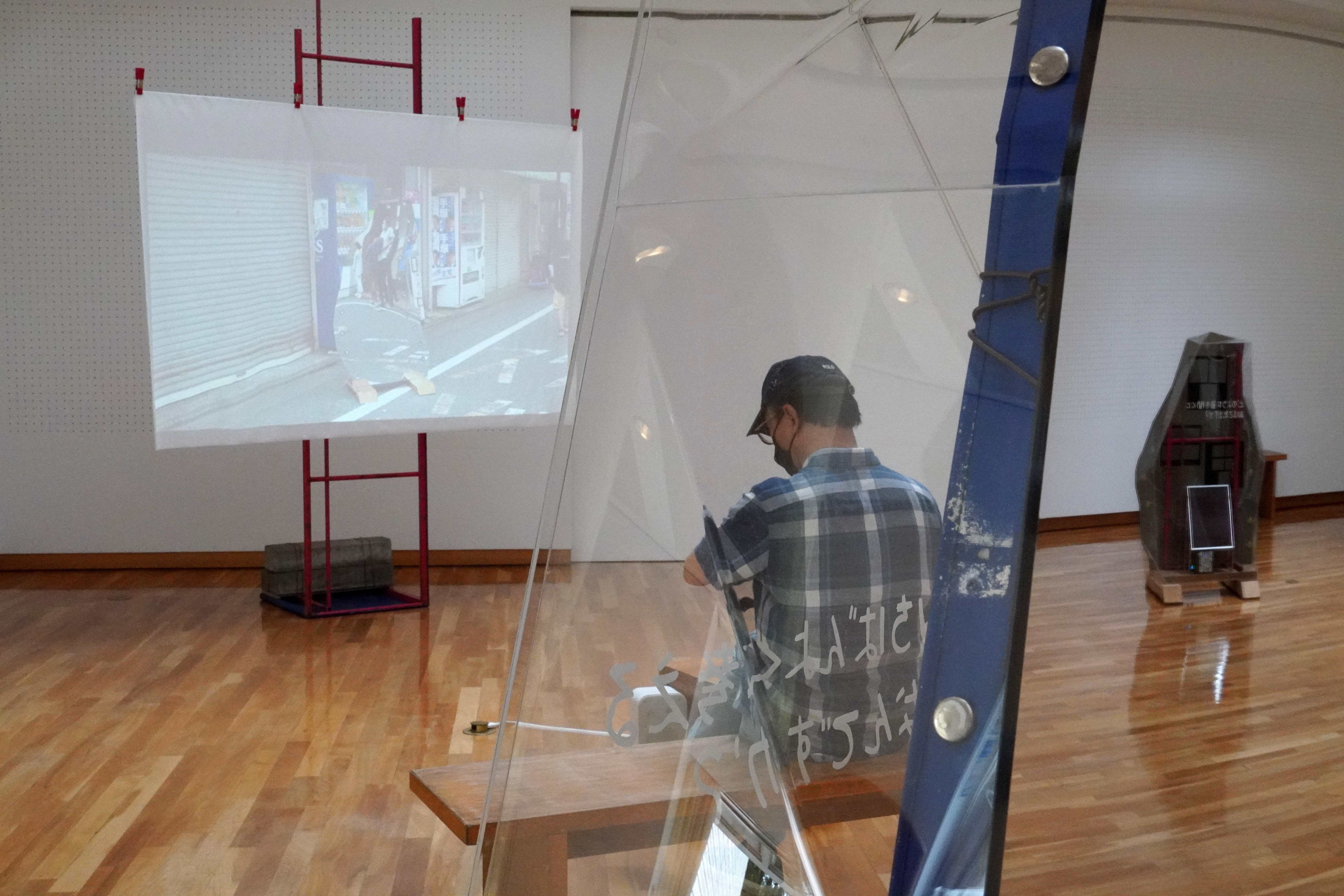
「旅はすみか」はそれぞれが多様なスキルを持った 日本とアメリカの2つ家族のアーティストによるチームです。それぞれが別の力を持ち合わせながら、別の視点を交差させ、人々と悲しみや希望を捉え直す機会を作ります。
アメリカ、カリフォルニアを拠点とするアーティスト夫婦marksearch は、
東日本大震災から10 年という節目をテーマにしたプロジェクト「旅はすみ Journey Itself Home」の制作のために日本に渡ってきました。世田谷在住のアーティスト夫婦、
阿部浩之・遠藤夏香とともに
「人と直接出会い、話を聞くこと」を大切にするアーティストとして 。
チームの詳細はこちら。
アメリカ、カリフォルニアを拠点とするアーティスト夫婦marksearch は、
東日本大震災から10 年という節目をテーマにしたプロジェクト「旅はすみ Journey Itself Home」の制作のために日本に渡ってきました。世田谷在住のアーティスト夫婦、
阿部浩之・遠藤夏香とともに
「人と直接出会い、話を聞くこと」を大切にするアーティストとして 。
チームの詳細はこちら。
Two artist families, one Japanese, and the other American, blend their diverse skills to create Journey Itself Home. One by one, we can each acknowledge our collective grief and find hope.
Sue Mark & Bruce Douglas, a California-based artist team, came to Japan in March, 2020 to create Journey Itself Home. Because of the constraints of the global pandemic, they have made Setagaya their home. Joining with Tokyo-based artists Hiroyuki Abe and Natsuka Endo, this Nichibei artist team values listening and learning from people.
Learn more about the team here.
Sue Mark & Bruce Douglas, a California-based artist team, came to Japan in March, 2020 to create Journey Itself Home. Because of the constraints of the global pandemic, they have made Setagaya their home. Joining with Tokyo-based artists Hiroyuki Abe and Natsuka Endo, this Nichibei artist team values listening and learning from people.
Learn more about the team here.